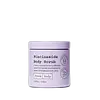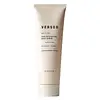What's inside
What's inside
 Key Ingredients
Key Ingredients

 Benefits
Benefits

 Concerns
Concerns

 Ingredients Side-by-side
Ingredients Side-by-side

Glycerin
HumectantSucrose
HumectantMagnesium Sulfate
Propanediol
SolventButyrospermum Parkii Butter
Skin ConditioningSodium Cocoyl Isethionate
CleansingCetearyl Alcohol
EmollientNiacinamide
SmoothingEuterpe Oleracea Fruit Extract
Lycium Barbarum Fruit Extract
AstringentVaccinium Myrtillus Fruit Extract
Skin ConditioningCamellia Sinensis Leaf Extract
AntimicrobialCoffea Arabica Seed Oil
MaskingAloe Barbadensis Leaf Juice Powder
Skin ConditioningWater
Skin ConditioningLauric Acid
CleansingParfum
MaskingPotassium Sorbate
PreservativeSodium Benzoate
MaskingCitric Acid
BufferingHexyl Cinnamal
PerfumingLimonene
PerfumingLinalool
PerfumingCI 60730
Cosmetic ColorantCI 17200
Cosmetic ColorantGlycerin, Sucrose, Magnesium Sulfate, Propanediol, Butyrospermum Parkii Butter, Sodium Cocoyl Isethionate, Cetearyl Alcohol, Niacinamide, Euterpe Oleracea Fruit Extract, Lycium Barbarum Fruit Extract, Vaccinium Myrtillus Fruit Extract, Camellia Sinensis Leaf Extract, Coffea Arabica Seed Oil, Aloe Barbadensis Leaf Juice Powder, Water, Lauric Acid, Parfum, Potassium Sorbate, Sodium Benzoate, Citric Acid, Hexyl Cinnamal, Limonene, Linalool, CI 60730, CI 17200
Water
Skin ConditioningPumice
AbrasiveLactic Acid
BufferingArginine
MaskingGlyceryl Stearate Se
EmulsifyingHelianthus Annuus Seed Oil
EmollientGlycerin
HumectantBehenyl Alcohol
EmollientCaprylic/Capric Triglyceride
MaskingGlycolic Acid
BufferingLactobacillus/Punica Granatum Fruit Ferment Extract
Skin ConditioningXanthan Gum
EmulsifyingCaprylyl Glycol
EmollientCetearyl Alcohol
EmollientCetearyl Glucoside
Emulsifying1,2-Hexanediol
Skin ConditioningIngredients Explained
These ingredients are found in both products.
Ingredients higher up in an ingredient list are typically present in a larger amount.
Cetearyl alcohol is a mixture of two fatty alcohols: cetyl alcohol and stearyl alcohol. It is mainly used as an emulsifier. Emulsifiers help prevent the separation of oils and products. Due to its composition, it can also be used to thicken a product or help create foam.
Cetearyl alcohol is an emollient. Emollients help soothe and hydrate the skin by trapping moisture.
Studies show Cetearyl alcohol is non-toxic and non-irritating. The FDA allows products labeled "alcohol-free" to have fatty alcohols.
This ingredient is usually derived from plant oils such as palm, vegetable, or coconut oils. There is debate on whether this ingredient will cause acne.
Due to the fatty acid base, this ingredient may not be Malassezia folliculitis safe.
Learn more about Cetearyl AlcoholGlycerin is already naturally found in your skin. It helps moisturize and protect your skin.
A study from 2016 found glycerin to be more effective as a humectant than AHAs and hyaluronic acid.
As a humectant, it helps the skin stay hydrated by pulling moisture to your skin. The low molecular weight of glycerin allows it to pull moisture into the deeper layers of your skin.
Hydrated skin improves your skin barrier; Your skin barrier helps protect against irritants and bacteria.
Glycerin has also been found to have antimicrobial and antiviral properties. Due to these properties, glycerin is often used in wound and burn treatments.
In cosmetics, glycerin is usually derived from plants such as soybean or palm. However, it can also be sourced from animals, such as tallow or animal fat.
This ingredient is organic, colorless, odorless, and non-toxic.
Glycerin is the name for this ingredient in American English. British English uses Glycerol/Glycerine.
Learn more about GlycerinWater. It's the most common cosmetic ingredient of all. You'll usually see it at the top of ingredient lists, meaning that it makes up the largest part of the product.
So why is it so popular? Water most often acts as a solvent - this means that it helps dissolve other ingredients into the formulation.
You'll also recognize water as that liquid we all need to stay alive. If you see this, drink a glass of water. Stay hydrated!
Learn more about Water